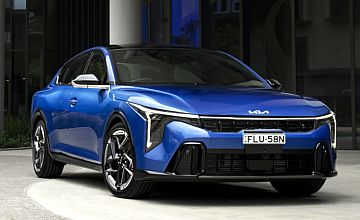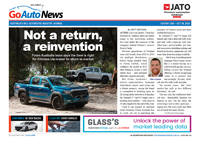Make / Model Search
OptionsCar reviews - Kia - K4Kia modelsOverviewWe like Delightful and confident handling, great ride comfort, stacks of features, turbo engine, cabin room Room for improvement Base engine a bit ho-hum, base model plastics, length may not fit your garage Kia K4 offers small-car sensibility with sports-car handling for a lot of family-size fun31 Jan 2025 By NEIL DOWLING Overview
FORGET perceptions of small sedans being boring to look at, spartan to sit in, and devoid of any on-road sparkle.
Kia’s Cerato replacement, the K4, is functional and well equipped, with the icing coming in the Australian version that thanks to local tuning, has handling prowess that a decade-old BMW could have trouble matching.
The K4 sedan (the long-lid hatchback version arrives later this year) also leapfrogs Kia’s popular and mainstay predecessor in every other area, save for adding a few grand in price to arrive in showrooms from $30,590 plus on-road costs.
Like the Cerato, the K4 will find love in the fleet business. It makes a lot of sense, has proven mechanicals (much carried over) and is spacious enough for four, maybe five, adults and a heap of luggage.
It also has the seven-year warranty and (relatively) low-cost capped-price service program that the lease and fleet business love, while still having attractive features for the private buyer.
Kia says the K4 will, indeed, appeal to business buyers. But it also said that typical of new models, fast sales will go initially to private owners who are expected to gravitate to the more expensive grade versions with the more virile turbocharged power plant.
The K4 marks an impressive upgrade to the Cerato and one that remains affordable with pricing starting at $30,590 (plus on-road costs) and up to $42,990 (+ORC) for the top-spec turbo GT-Line version.
In growing into the new-gen model, the K4 also gets bigger and even Kia admits the new model – at 4700mm long – is on the threshold of the medium-size car segment. The only thing keeping it “small” is the incoming hatchback that is a bit shorter.
In comparison, the K4 is almost identical in size to Australia’s key 1974 family car, the Holden HQ Belmont. It’s also about the same price (age and CPI adjusted) when new and yet is more powerful (88kW versus 112kW) and is twice as economical (14.3L/100km versus K4’s 7.4L/100km). Progress.
Kia has this week released capped-price service costs for the K4 that averages $460 a year for seven years for the 2.0-litre model, and an average of $554 a year for the turbocharged 1.6-litre in the GT-Line.
Drive Impressions
Kia offers a decent choice for powerplants in the K4. One for function, the other for a bit more excitement.
The base 2.0-litre engine carries over and while it’s assumed it’s the poor cousin to the ‘hot’ turbo version, on the road the normally aspirated engine is brisk enough to meet its target market head on.
Initial acceleration is smooth, sufficiently muted but not especially responsive or strong. It is, however, a bit deceiving. The engine pulls well at low speeds and through the mid-range, easing off at higher revs to indicate anything beyond 5000rpm (or 5.0 as the new-age tacho says) is pointless.
Much of the appeal of the engine lies in its flexibility and smooth low-speed work, particularly in its relationship with the six-speed conventional automatic transmission that offers a broad ratio mix for the engine to play with.
The test drive returned 8.8L/100km despite some heavy right-foot exercises.
The top-shelf 1.6-litre turbocharged version also carries over from the previous model, albeit with a bit less power and a new transmission.
Power is now 142kW with 264Nm of torque, compared with the outgoing Cerato at 150kW/265Nm, while fuel consumption is claimed to be 6.7L/100km, the same as before. This engine sounds more purposeful at idle, with far more response to accelerator pedal pressure than the 2.0-litre.
More sparkling and eager off the mark, it also enjoys extending its rev range right towards 6000rpm and is still delivering horses towards the redline.
The gearbox changes from a seven-speed dual-clutch transmission (DCT) to the K4’s eight-speed torque convertor auto.
This is similar to moves made at Volkswagen and Ford for selected models that had high – and really expensive – recall for DCT problems. Kia denied that the change was attributed to warranty issues and breakdowns with its DCT.
Regardless, the new auto is smoother and easier to use, makes hill starts a breeze and the extra cog makes up for any of its outgoing DCT’s fast gearchange advantages.
Fleets, and others conscious of breakdown costs and time penalties, will think the new auto is a gift.
By comparison, the 1.6-litre GT-Line version is obviously quicker and more enjoyable to hustle around winding country roads.
Add to that the handling improvements, and the GT-Line becomes a car that could fit into the sports sedan category, attracting buyers who want performance with sensible car ownership.
The drive program for this GT-Line car returned an average of 7.8L/100km, compared with Kia’s claimed 6.7L/100km, and in line with the verve with which it was driven.
Kia Australia again localised the handling of the K4 through Graeme Gambold’s Victorian engineering business and again, the results elevate the sedan from a ho-hum suburban garage and road filler to a sparkling car that turns in neatly and confidently.
The work also extends to the ride comfort, with excellent bump absorption on rutted bitumen and particularly on poorly surfaced corners which could normally upset the steering and ride.
Steering is also improved and while it feels light initially, it firms slightly at higher speeds so is well set up for country road cornering. The firmer steering gives the impression of better control.
I don’t know if I’m sold on the ‘double-D’ steering wheel – chamfered at both the top and bottom for ease of driver entry/exit – but it only becomes noticeable when transitioning from one hard lock to the other, as in parking manoeuvres.
Visibility is generally good and while the A-pillars are wide, it’s not something that is unique to the K4. I like the instrument panel clarity and simplicity and the fact that some functions – including HVAC – have intentionally been left manual.
There’s not much worse – and dangerous – than a driver trying to adjust air-con temperatures and fans through an overly lethargic touchscreen while the car is moving…
Cabin space is also excellent. There’s a heap of legroom in the rear seat behind the 1.76cm driver which augers well for the family and for transporting adults.
The boot is also huge and even the standard boot lid offers enough room for large luggage. The boot floor hides a space-saver spare.
 Read more24th of January 2025  Mexican standoff looms for KiaSole supplier of Kia K4 sedan under threat as Trump considers Mexico shut-out16th of January 2025  Kia K4 replaces outgoing CeratoPrice increases for Kia small car range as K4 arrives from $30,590 plus on-road costs14th of January 2025  Kia K4All car reviews Alfa Romeo Alfa Romeo Abarth Abarth Audi Audi Aston Martin Aston Martin BMW BMW Bentley Bentley Chrysler Chrysler Chevrolet Chevrolet Dodge Dodge Citroen Citroen Ferrari Ferrari DS DS Ford Ford Fiat Fiat FPV FPV Foton Foton Haval Haval Great Wall Great Wall Honda Honda Holden Holden Hyundai Hyundai HSV HSV Isuzu Isuzu Infiniti Infiniti Jaguar Jaguar Iveco Iveco Kia Kia Jeep Jeep Land Rover Land Rover Lamborghini Lamborghini Maserati Maserati Lexus Lexus McLaren McLaren Mazda Mazda Mercedes-Benz Mercedes-Benz Mitsubishi Mitsubishi Mini Mini Opel Opel Nissan Nissan Porsche Porsche Peugeot Peugeot Ram Ram Proton Proton Rolls-Royce Rolls-Royce Renault Renault Skoda Skoda Saab Saab SsangYong SsangYong Smart Smart Suzuki Suzuki Subaru Subaru Toyota Toyota Tesla Tesla Volvo Volvo |
OptionsClick to share
|










Facebook Twitter Instagram